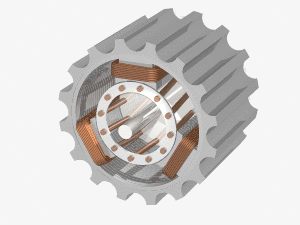Induction Motors
Induction Motors
Induction motors are termed "induction" because there is no current supplied to the rotating coils. The coils are closed loops which have large currents induced in them by the changing magnetic field produced in the stator coils.<ref>http://hyperphysics.phy-astr.gsu.edu/HBASE/magnetic/indmot.html</ref> This is different from a synchronous AC motor because it has a current supplied onto the rotor.
There are two main types of induction motors.
The first type is an adjustable-speed drive. These are used in the process control industry to adjust the speed of fans, compressors, pumps, blowers, etc. Also, these are used for electric traction in hybrid vehicles.
The second type is a servo drive. These emulate the performance of a DC-motor drive and are used in machine tools, robotics, etc.
Squirrel-Cage Induction Motor

These are commonly used in adjustable-speed applications. The cage has bars of copper or aluminum running the length of the rotor. In most working motors, the bars are skewed from following the axial direction of the motor to reduce noise. The bars are shorted at each end of the rotor by end rings, and thus producing a cage like structure.
The stator of an induction motor has three windings which are displaced by 120o with respect to each other. <ref>Electric Drives by Ned Mohan</ref> These stator windings are arranged around the rotor so that when energized with an alternating current they create a rotating magnetic field which sweet past the rotor. The changing magnetic field induced the current. The currents interact with the rotating magnetic field and causes a rotational motion on the rotor. <ref>http://en.wikipedia.org/wiki/Induction_motor</ref>
References:
<references/>